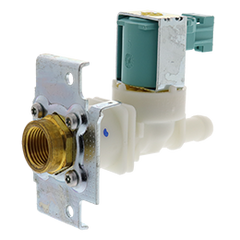
Dishwasher is Leaking
It’s common for dishwashers with worn or damaged parts to leak and cause a real headache for you. However, finding the problem part and making the right fix is easy, even for folks who are new to DIY. On this page, you’ll find a quick run-through of all the parts that could be causing problems for your dishwasher and causing it to leak. We’ve got ways to test the parts to see if they’re working properly, plus links to buy replacement parts should you need them. Happy fixing!
If a pump is damaged or defective, it can cause a leak. The pump is responsible for pumping water into the dishwasher and in some cases removing the water as well. Any damage to the integrity of the pump will cause leaking. There are also other components involved that can become defective over time and cause leaking.
Note: To troubleshoot a dishwasher pump you must handle electrical components. You must disconnect your washer before you do this. We recommend enlisting the help of an experienced professional before attempting to troubleshoot your motor.
How to Troubleshoot a Dishwasher Pump:
Note: this process requires a multimeter
- Disconnect the dishwasher from its power source.
- Locate and remove the dishwasher pump - it can typically be found behind the lower access panel.
- Use the multimeter on the RX1 setting to test the dishwasher pump. Place the probes on the terminals to test for continuity. Look to receive a reading of zero or close to zero.
- Use the multimeter on the RX1 setting to test the dishwasher pump’s ground connection. Touch one probe to the terminal and one to the metal exterior of the pump. You should not receive any reading.
- If you receive different results from your tests than those listed above, you must replace your dishwasher pump.
Don’t forget: just because parts look the same does not mean that they are the same. Make sure to use cross reference information and model numbers to confirm compatibility with your dishwasher.
Find the right pump for your dishwasher here!
The dishwasher door gasket creates an airtight seal between the inside of the dishwasher and the outside. If the gasket becomes damaged or worn, then the seal is compromised and the water on the inside of the dishwasher will inevitably leak out. Gaskets are easy to inspect visually, so this one is quick and simple to troubleshoot.
How to Troubleshoot a Dishwasher Door Gasket:
- Open your dishwasher to find the door gasket.
- Examine the gasket for any sign of damage, wear, or breakage. It might also be misaligned - straighten the gasket if necessary.
- If you do find signs of damage, you must replace the dishwasher door gasket.
Don’t forget: just because parts look the same does not mean that they are the same. Make sure to use cross reference information and model numbers to confirm compatibility with your dishwasher.
The water inlet valve is the part that connects to your dishwasher’s water line and into the appliance. If it is damaged or worn, it can create a leak. You can find the water valve behind the appliance’s lower access panel. It’s easy to visually inspect the water valve to look for problems.
How to Troubleshoot a Dishwasher Water Valve:
- Disconnect the dishwasher from its power source.
- Disconnect the dishwasher from the water line.
- Remove the lower access panel.
- Locate the water valve - it can typically be found on the left side behind the panel.
- You can visually inspect the valve for visual signs of damage or wear.
- If you find any damage or wear, you must replace the dishwasher water valve.
Don’t forget: just because parts look the same does not mean that they are the same. Make sure to use cross reference information and model numbers to confirm compatibility with your dishwasher.
The spray arms shoot water throughout the dishwasher during its operation. Typically, dishwashers have spray arms on the bottom of the appliance but some of them have spray arms at the top. In some cases, the spray arms can get out of alignment and spray outside of the intended area. This can cause water to pool and create a leak.
How to Troubleshoot a Spray Arm:
- Disconnect the dishwasher from its power source.
- Inspect the arms for visible signs of damage like cracking, separation or wear.
- Attempt to manually spin the spray arms. You should check for resistance when spinning. Check for wobbling and see if the arms are out of alignment.
- Inspect the spray arm holes for blockage and remove any blockage that you might find.
- If you find that your spray arm is out of alignment, you must replace your spray arm.
Don’t forget: just because parts look the same does not mean that they are the same. Make sure to use cross reference information and model numbers to confirm compatibility with your dishwasher.




